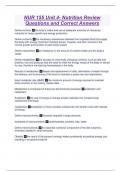NUR 155 Unit 4- Nutrition Review
Questions and Correct Answers
Define nutrition ✅the body's intake and use of adequate amounts of necessary
nutrients for tissue growth and energy production
Define nutrients ✅the necessary substances obtained from ingested food that supply
the body with energy; build and maintain bones, muscles, and skin; and aid in the
normal growth and function of each body system
Define malnutrition ✅an imbalance in the amount of nutrient intake and the body's
needs
Define metabolism ✅the process of chemically changing nutrients, such as fats and
proteins, into end products that are used to meet the energy needs of the body or stored
for use, therefore maintaining homeostasis in the body
Results of metabolism ✅Repair and replacement of cells, elimination of waste through
the kidneys, and functioning of the brain to maintain a pulse rate and respirations
basal metabolic rate (BMR) ✅the minimum amount of energy required to maintain
body functions in the resting, awake state
Metabolism is composed of these two biochemical processes ✅anabolism and
catabolism
Anabolism ✅the use of energy to change simple materials into complex body
substances and tissue
Catabolism ✅breakdown of more complex substances into simpler ones with release
of energy
Define macronutrients ✅Nutrients required in large amounts
examples of macronutrients ✅carbohydrates, proteins, fats, water
Define micronutrients ✅An essential nutritional component of the diet (vitamins,
minerals) needed in small amounts.
Obesity ✅the result of the person's energy intake consistently exceeding energy use,
resulting in excessive body fat
, Carbohydrates ✅-supply the body with 4kcal/gram
- recommended that 50% of calories come from carbs
-includes sugars, starches, and fibers
-major suppliers of energy
-keep the body from using valuable proteins for energy, prevent ketosis, and enhance
memory and learning capabilities
simple carbohydrates ✅-broken down and absorbed quickly (quick energy source)
-sugars in fruits, milk products, blood sugar, and sugar cane
complex carbohydrates ✅-composed of starches, glycogen, and fiber
-take longer to break down
-derived from "stored fuel"
-bread, rice, pasta, legumes (dried beans, peas, lentils), starchy veggies (corn,
pumpkin, green peas, potatoes)
Fiber ✅-a complex carbohydrate and is classified as soluble (mixes with water,
causing slower digestion) or insoluble (doesn't retain water, but passes faster in through
digestive tract)
-lack of fiber can lead to bowel related conditions (hemorrhoids, constipation, formation
of diverticula)
fiber food sources ✅Whole grains, wehat bran, cereals, fresh vegetables, fruits, and
legumes
Fats ✅-lipids, needed for energy and supports cellular growth
-9 kcal/gram, average consumption recommendation between 20%-35% of caloric
intake (less than 5%-6% from saturated fats)
-promotes energy production, support/insulation of major organs/nerve fibers, energy
storage, lubrication for body tissues, vitamin absorption, and transportation of fat-
soluble vitamins A, D, E, and K
Triglycerides ✅most abundant lipids in your body and the richest source of energy
saturated fatty acids ✅-contain as many hydrogen atoms as the carbon atoms can
bond with and no double carbon bonds
-found in hard margarines, vegetable shortenings, pastries, crackers, fried foods,
cheese, ice cream, other processed foods
monosaturated fatty acid ✅-have only one double bond between carbon atoms
-canola/olive/peanut oils, almonds, sesame seeds, avocados, cashews
polyunsaturated fatty acid ✅-a fatty acid containing multiple pairs of double carbon
bonds
-corn, safflower, sesame, soybean, sunflower seed oils (fish)




